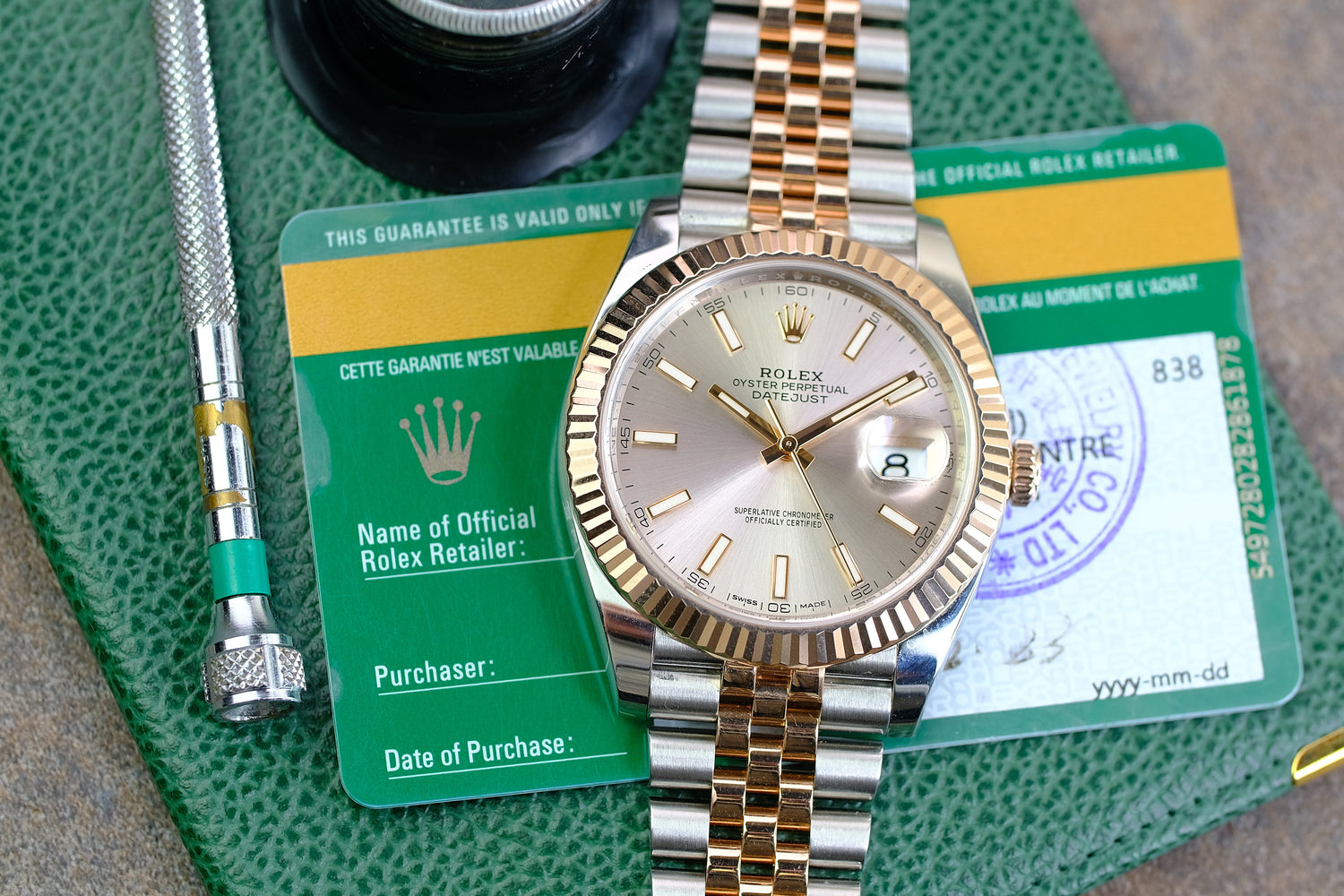The Evolution of the Rolex Datejust: From Its Inception to the 126233
The Rolex Datejust is one of the most iconic timepieces in horological history. Since its introduction in 1945, it has set the standard for elegance, precision, and innovation. Known for being the first automatic wristwatch to feature a date display that changes automatically at midnight, the Datejust has continuously evolved while retaining its timeless appeal. Let’s explore the journey of the Rolex Datejust from its earliest reference to the modern 126233.
The Birth of the Rolex Datejust and the Jubilee Bracelet (1945)
The Rolex Datejust made its debut in 1945 with reference 4467, marking Rolex’s 40th anniversary. This revolutionary timepiece introduced an automatic date-change feature, a first in wristwatch technology. The reference 4467 was available only in 18k yellow gold, emphasizing the luxury and exclusivity of this groundbreaking watch. Alongside the Datejust, Rolex also introduced the now-iconic five-piece link Jubilee bracelet, specially designed for the model. This innovation, paired with the Oyster case, established the Datejust as a durable, elegant, and functional watch.

The Datejust immediately captured attention not only for its technical innovations but also for its enduring design, which laid the foundation for future generations of this iconic model.
The Rolex Datejust in the 1960s: Reference 1601
The 1960s saw the release of the reference 1601, which refined the Datejust’s design with a slimmer profile and more sophisticated movement, the Caliber 1575. Available in stainless steel, yellow gold, and white gold, this model expanded the reach of the Datejust to more wearers. The fluted bezel became a key design element, while the Jubilee bracelet continued to enhance its comfort and elegance.

The reference 1601 represented the culmination of Rolex's mid-century innovations, with the Datejust becoming a status symbol for those seeking both form and function.
The Evolution to References 16013 and 16014 (Late 1970s to 1980s)
In the late 1970s, Rolex introduced the 16013 and 16014 references, which built on the legacy of the 1601. These models introduced the Caliber 3035 movement, a significant upgrade that brought the quickset date function to the Datejust. This allowed wearers to adjust the date independently of the time, making it far more convenient.
- Reference 16013: A two-tone (Rolesor) model combining stainless steel and 18k yellow gold with the signature fluted bezel.
- Reference 16014: A stainless steel version with a white gold bezel, offering a more understated elegance.
Both references retained the acrylic crystal, a common feature of Rolex watches from this era, giving them a vintage charm still appreciated by collectors today. These models helped bridge the transition between vintage and modern Datejusts.

The Transition to Sapphire Crystals and the Caliber 3135: References 16233 and 16234 (1988)
In 1988, Rolex introduced the references 16233 and 16234, marking another step forward in the evolution of the Datejust.
- Reference 16233: A two-tone (Rolesor) model, combining stainless steel and 18k yellow gold with a fluted bezel.
- Reference 16234: A stainless steel version with a white gold fluted bezel.
Both references were equipped with the Caliber 3135 movement, which improved precision and reliability over the previous Caliber 3035. The quickset date function remained, but the 3135 introduced a longer power reserve and more robust architecture.
Additionally, these models were the first Datejust references to feature sapphire crystals, offering enhanced scratch resistance and giving the watch a more modern appearance. This transition to sapphire crystals and the upgraded movement made the 16233 and 16234 staples in the modern Rolex lineup, and they remain highly sought after by collectors today.

The 116200, 116233, 116234 Series: A Further Refinement of the Datejust
By the mid-2000s, Rolex introduced the next evolution in the Datejust lineup with the 116200, 116233, and 116234 references. These models retained the classic 36mm case size but came with several technical and aesthetic improvements.
- Reference 116200: A stainless steel model with a smooth bezel, offering a refined and understated option for those seeking a more minimalist look.
- Reference 116233: A two-tone model with the signature Rolesor combination of stainless steel and 18k yellow gold, featuring a fluted bezel.
- Reference 116234: A stainless steel version with a white gold fluted bezel, continuing the tradition of blending precious metals with the timeless Oyster case design.
These references continued to use the Caliber 3135 movement, known for its reliability and precision. They also featured sapphire crystals, ensuring durability and scratch resistance. Rolex subtly refined the case design, giving it slightly thicker lugs and a more modern look.
A major improvement in this series was the update to the clasps of both the Oyster and Jubilee bracelets. The new clasps featured the Rolex Oysterclasp with a concealed Crownclasp for the Jubilee bracelet and an improved Oysterclasp for the Oyster bracelet. These updated clasps offered a more refined aesthetic, a more secure closure, and included the Easylink extension system, which allowed the wearer to adjust the bracelet length by 5mm for added comfort.


The First 41mm Datejusts: References 116300, 116333, and 116334 (Datejust II)
In the mid-2000s, Rolex expanded the Datejust line with the introduction of the first 41mm Datejusts, beginning with references 116300, 116333, and 116334. These larger models, known as the Datejust II, were designed to cater to modern trends favoring larger wristwatches while maintaining the classic Datejust aesthetic.
- Reference 116300: A stainless steel model with a smooth bezel.
- Reference 116333: A two-tone steel and 18k yellow gold version with a fluted bezel.
- Reference 116334: A stainless steel model with a white gold fluted bezel.
One key distinction of the Datejust II line (the 116 series) was that these models were only available with Oyster bracelets. The robust, sportier look of the Oyster band complemented the larger case size, but Rolex did not offer the more refined Jubilee bracelet for this line.

To accommodate the larger case size, Rolex adjusted the movement by introducing an enhanced version of the Caliber 3136, which was an evolution of the 3135. The 3136 provided additional support for the increased weight and size of the case, while retaining the precision, durability, and quickset date function that had become hallmarks of the Datejust line.
The Evolution to Datejust 41: References 126300, 126333, and 126334
In 2016, Rolex introduced the Datejust 41, which replaced the Datejust II and brought several refinements. These models, identified by the 126 references, such as 126300, 126333, and 126334, retained the 41mm case size but featured a more elegant and proportional design compared to the bulkier Datejust II.
A major update in the Datejust 41 series was the reintroduction of the Jubilee bracelet as an option alongside the Oyster bracelet, giving buyers more versatility in terms of style. The Jubilee bracelet was particularly popular for those seeking a more traditional and dressier look.

The Datejust 41 models were powered by the new Caliber 3235, featuring a 70-hour power reserve and the advanced Chronergy escapement, improving both energy efficiency and precision. This movement represented the latest in Rolex innovation, maintaining the Datejust’s reputation for reliability and performance.
Additionally, the Datejust II models (116300, 116333, 116334) are referred to as Datejust II, while the 41mm Datejust models from the 126 line are now called Datejust 41. This change reflects the subtle differences in design and proportions between the two series, with the Datejust 41 offering a slimmer, more refined profile compared to the bulkier Datejust II.
The Transition from the 1162- to the 1262- Line of Rolex Datejusts
The 1162- line of Rolex Datejusts (e.g., 116233, 116234) introduced in the mid-2000s brought modern refinements to the classic Datejust 36mm. These models featured the Caliber 3135 movement, which was already known for its reliability and precision. The 1162- models came with both Oyster and Jubilee bracelet options, and they included the Oysterclasp with the Easylink extension system, providing wearers with a 5mm micro-adjustment for added comfort. The case design was also slightly bulkier compared to earlier models, giving it a more substantial wrist presence.
Key Differences between the 1162- and 1262- Lines
The 1262- line, including references like the 126233 and 126234, was introduced in the late 2010s and represents a significant evolution from the 1162- line. Several key updates differentiate the 1262- line from its predecessor:
-
Movement: The most important update is the switch from the Caliber 3135 (in the 1162- series) to the Caliber 3235 in the 1262- models. The Caliber 3235 introduces Rolex's new Chronergy escapement, which improves energy efficiency by 15%. This allows for a longer 70-hour power reserve compared to the 48-hour power reserve of the Caliber 3135.
-
Case Design: The 1262- models feature a more refined and slimmer case profile compared to the slightly bulkier 1162- models. The lugs and bezel are sleeker, giving the watch a more modern and elegant appearance without sacrificing the traditional 36mm case size.
-
Bracelets: Both lines offer the Oyster and Jubilee bracelets with Oysterclasp and Crownclasp, but the finishing on the 1262- line’s bracelets is slightly more polished, providing a more refined look and feel.
-
Date Display: The 1262- line retains the iconic date function with the Cyclops lens over the date window. However, improvements in the date-change mechanism allow for smoother and quicker operation in the 1262- series.
-
Durability: The 1262- models boast greater durability, largely due to enhancements in the Caliber 3235 movement, which includes a more robust barrel, longer power reserve, and resistance to magnetism. These updates make the 1262- series better suited for modern wearers who demand higher precision and robustness in their watches.
The transition from the 1162- to 1262- line represents Rolex's commitment to continuous improvement, with each new generation offering incremental innovations while maintaining the Datejust’s timeless appeal.
The Modern Datejust: Reference 126233
The evolution of the Rolex Datejust continues into the present day with the reference 126233, one of the latest iterations of the Datejust 36. Introduced in the late 2010s, this model represents the pinnacle of Rolex engineering.

The 126233 is powered by the Caliber 3235 movement, which boasts a 70-hour power reserve and incorporates Rolex’s cutting-edge Chronergy escapement, offering greater energy efficiency and precision.





Leave a comment
This site is protected by hCaptcha and the hCaptcha Privacy Policy and Terms of Service apply.